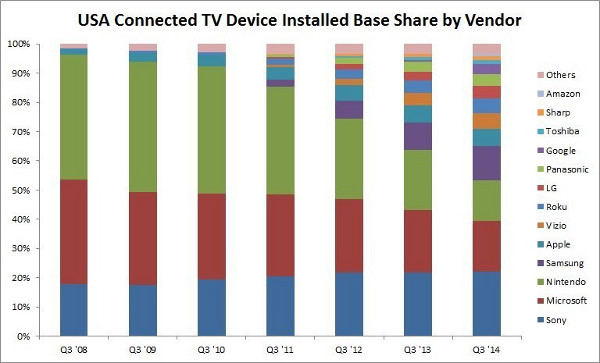1.9 connected TV devices per broadband household in USA
Wednesday, December 10th, 2014Average Connected TV Devices per Broadband Household in USA reaches 1.9 in Q3 2014
- New Strategy Analytics Quarterly Tracker Finds 43 Percent of Connected TV Devices In Use are Games Consoles but Smart TVs, Standalone Media Streamers Catching Up
BOSTON — Ownership of Connected TV Devices (including smart TVs, smart blu-ray players, IP-enabled game consoles and digital media streamers) grew 5 percent quarter-on-quarter in Q3 2014 and 28 percent year-on-year to reach 168 million units. Fuelled by a desire to watch video content delivered via the open Internet, the average US home now owns 1.9 Connected TV devices compared to 1.5 in Q3 2013 according to Strategy Analytics’ Connected Home Devices (CHD) service report, “USA Connected TV Device Tracker: Q3 2014”.
Other key findings from the report include:
 Sony led the US IP Games Console market for the third consecutive quarter capturing just under 50 percent of unit shipments in Q3. Microsoft claims the largest installed base of all three console vendors though with close to 30 million Xbox’s in use in the country.
Sony led the US IP Games Console market for the third consecutive quarter capturing just under 50 percent of unit shipments in Q3. Microsoft claims the largest installed base of all three console vendors though with close to 30 million Xbox’s in use in the country.- Samsung is the dominant player in the US Smart TV market claiming 35 percent share of units shipments during the third quarter. Vizio was second followed by Sony and LG.
- Apple slipped to third in the Digital Media Streamer market in Q3 2014 having led the market just 12 months previously. Google’s Chromecast took top spot with 26 percent share of shipments followed closely by Roku.
David Watkins, Service Director, Connected Home Devices commented: “Competition within the US Connected TV Device market is intensifying as device makers battle to be the gateway of choice for watching online videos on the TV screen. Heavyweight brands Google and Amazon have shaken up the market and have created a huge surge in demand for low-cost media streaming dongles. These devices may not provide as sophisticated an experience as an integrated Smart TV but often provide a much faster and easier way for consumers to get access to their favorite online streaming service”.
Eric Smith, Analyst, Connected Home Devices said: “The Connected TV device market today is characterized by proprietary platforms but the market of tomorrow may well come to be defined by open source operating systems. Google’s Android TV platform has been set loose, LG is replacing its platform with WebOS and the first Tizen supported Smart TVs are expected to emerge in 2015 from Samsung. Such openness of standards may well be the key to unleashing the true capabilities of Connected TV”.
Latest News
- Barb to start reporting TV-set viewing of YouTube channels
- SAT FILM selects multi-DRM from CryptoGuard
- Qvest and ARABSAT to launch OTT streaming platform
- ArabyAds & LG Ad Solutions partner with TVekstra in Turkey
- Freeview NZ satellite TV service to move to Koreasat 6
- Comscore expands YouTube CTV measurement internationally
